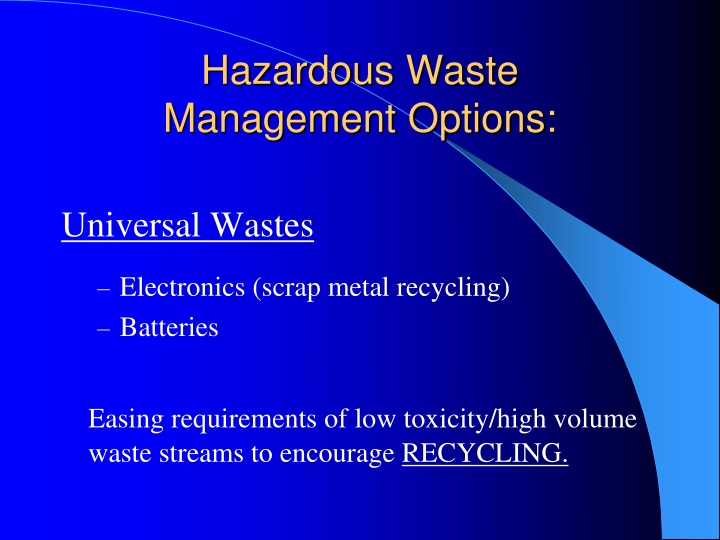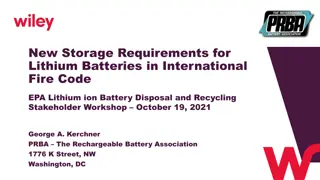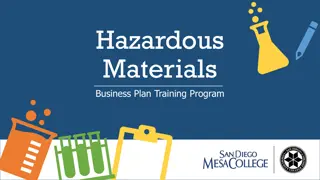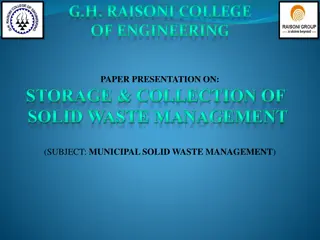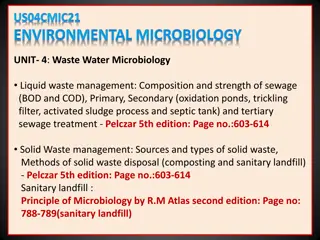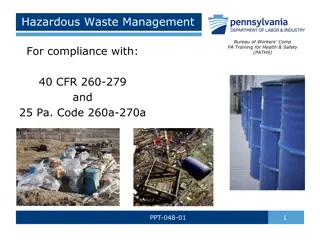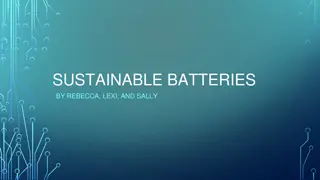Effective Hazardous Waste Management Strategies for Electronics and Batteries
Implementing proper waste management strategies for electronics and batteries is crucial to promote recycling and prevent environmental harm. The policy outlines procedures for disposing of electronic waste, including the collection of usable equipment for surplus handling. Additionally, it emphasizes the importance of battery recycling, distinguishing between hazardous and non-hazardous battery types and providing guidelines for recycling. By following these practices, organizations can contribute to a cleaner and healthier environment.
Download Presentation

Please find below an Image/Link to download the presentation.
The content on the website is provided AS IS for your information and personal use only. It may not be sold, licensed, or shared on other websites without obtaining consent from the author.If you encounter any issues during the download, it is possible that the publisher has removed the file from their server.
You are allowed to download the files provided on this website for personal or commercial use, subject to the condition that they are used lawfully. All files are the property of their respective owners.
The content on the website is provided AS IS for your information and personal use only. It may not be sold, licensed, or shared on other websites without obtaining consent from the author.
E N D
Presentation Transcript
Hazardous Waste Management Options: Universal Wastes Electronics (scrap metal recycling) Batteries Easing requirements of low toxicity/high volume waste streams to encourage RECYCLING.
ELECTRONICS COMPUTERS COMPONENTS COMPUTER BOARDS HARD DRIVES MODEMS CASES PRINTERS ALL OFFICE ELECTRONICS MEDICAL ELECTRONICS OF ANY KIND
SUNY INSTITUTE OF TECHNOLOGY AT UTICA/ROME ELECTRONIC WASTE POLICY
SUNY INSTITUTE OF TECHNOLOGY AT UTICA/ROME ELECTRONIC WASTE POLICY Electronic waste cannot be disposed of in the regular trash and must be managed in accordance with the NYS DEC rules (NYCRR 371.1) due to the content of lead, silver, cadmium and other heavy metals. To dispose of electronic waste in the proper manner, you should forward a work order to Facilities to arrange for pick-up. To increase efficiency, each department/school should temporarily store a number of electronic units prior to requesting a pick-up. No charge to the department for this service.
ELECTRONIC WASTE POLICY (CONTINUED) Useable electronic computer equipment, with processor and/or monitor in working order can be handled as surplus equipment as described in the surplus equipment policy. NOTE: if electronic waste is found in the regular trash stream it will not be picked-up. The EHS Office will be notified and the Dean and/or Department Head of that area will be notified.
Procedure for Battery Recycling Some batteries contain enough acid or heavy metals to be considered hazardous waste . Not all batteries need to be recycled. Regular household or flashlight alkaline batteries are now made without heavy metals like mercury & lead and may be thrown away in the regular trash Car batteries are lead-acid batteries and are returned to the manufacturer.
BATTERY TYPES NON -RECHARGEABLE TYPE COMMON USES HAZARDOUS COMPONENT RECYCLING PROCEDURE OF BATTERY Carbon Zinc and Alkaline Flashlights Non-Hazardous Non-Hazardous Solid Waste (Regular Trash) RECYCLE BIN #3 OTHER BATTERIES Mercuric Oxide Cameras, Mercury Calculators, Watches RECYCLE BIN #3 OTHER BATTERIES Button Cameras, Calculators, Watches, Pagers Silver/Mercury (Silver Oxide/Zinc- air) RECYCLE BIN #2 METAL BATTERIES Lithium Computers, Cameras Lithium
BATTERY TYPES RECHARGEABLE TYPE COMMON USES HAZARDOUS COMPONENTS RECYCLING PROCEDURE OF BATTERY RECYCLE BIN #1 LEAD-ACID Lead-Acid (sealed or otherwise) Tools, Camcorders Lead Alkaline Flashlights Non-Hazardous Non-Hazardous Solid Waste (Regular Trash) RECYCLE BIN #2 METAL BATTERIES RECYCLE BIN #2 METAL BATTERIES RECYCLE BIN #2 METAL BATTERIES Nickel-Cadmium Smoke Alarms, Tools, Various Cadmium Nickel Metal Hydride Cell Non-Hazardous Recycle for Nickel Cont Phones,Computers Lithium Ion Cell Phones, Computers Lithium
BATTERY COLLECTION CONTAINER LOCATIONS KUNSELA HALL -INSIDE INSTRUCTIONAL RESOURCES CAMPUS CENTER -INSIDE LOADING DOCK DONOVAN HALL -INSIDE LOADING DOCK CALL EHS OR FACILITIES FOR ASSISTANCE WITH LEAKING BATTERIES
